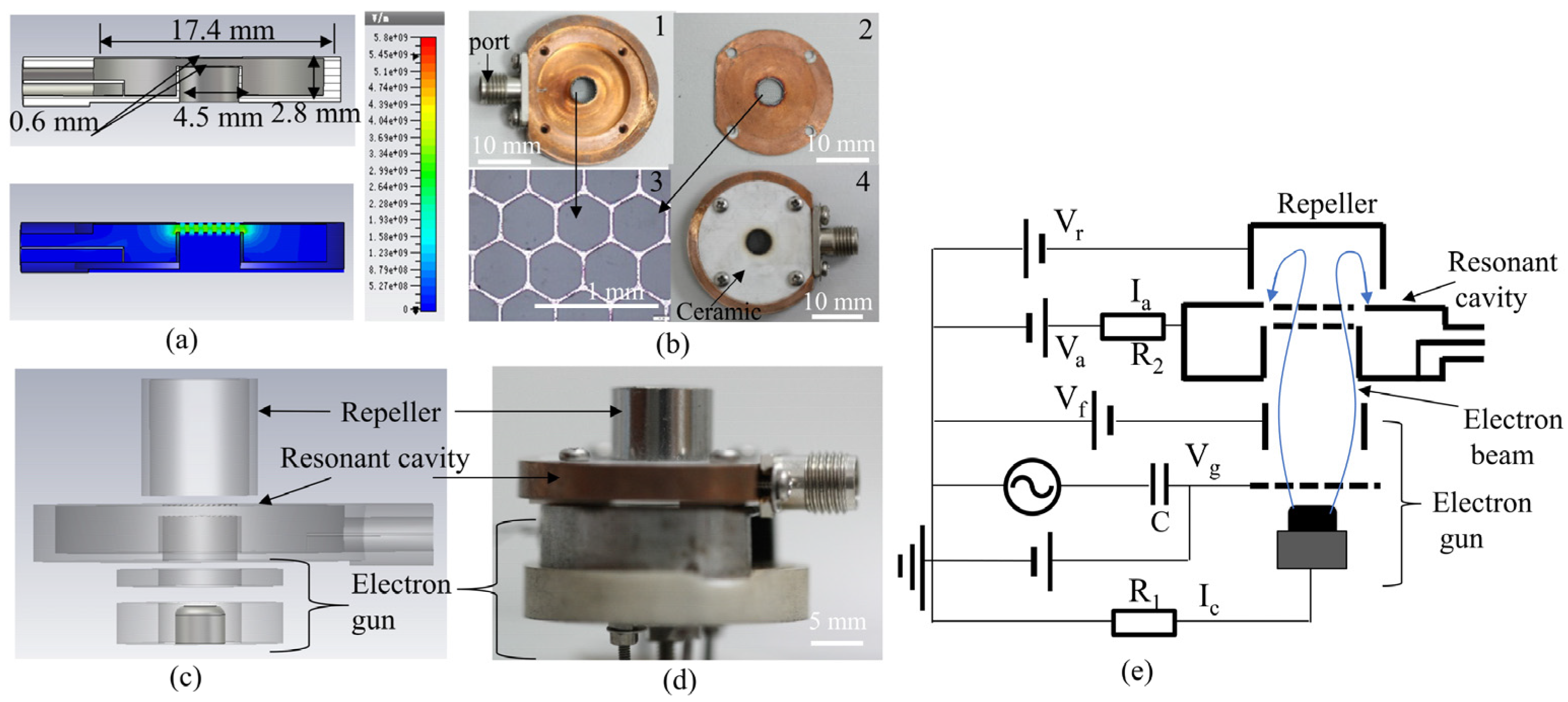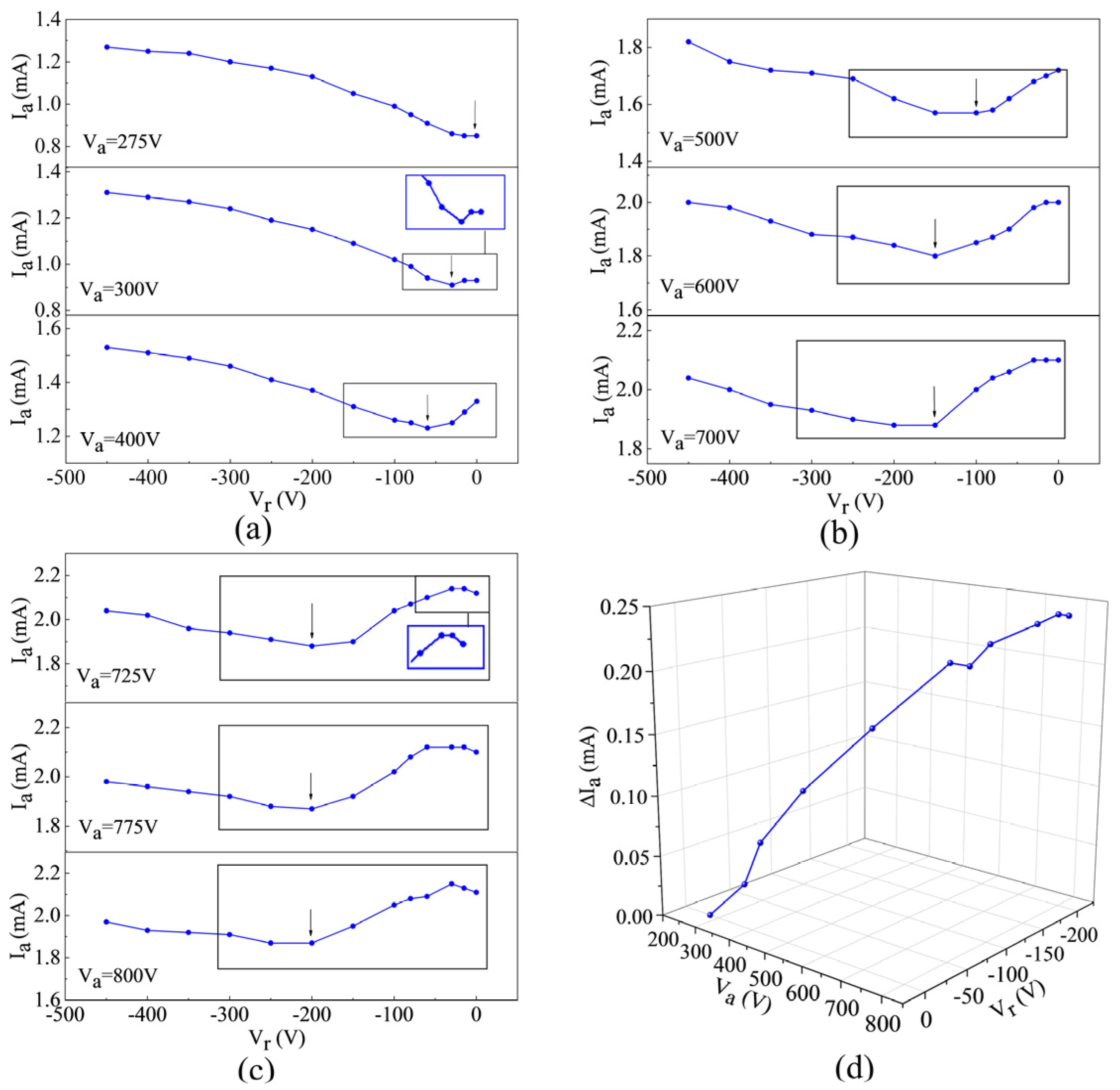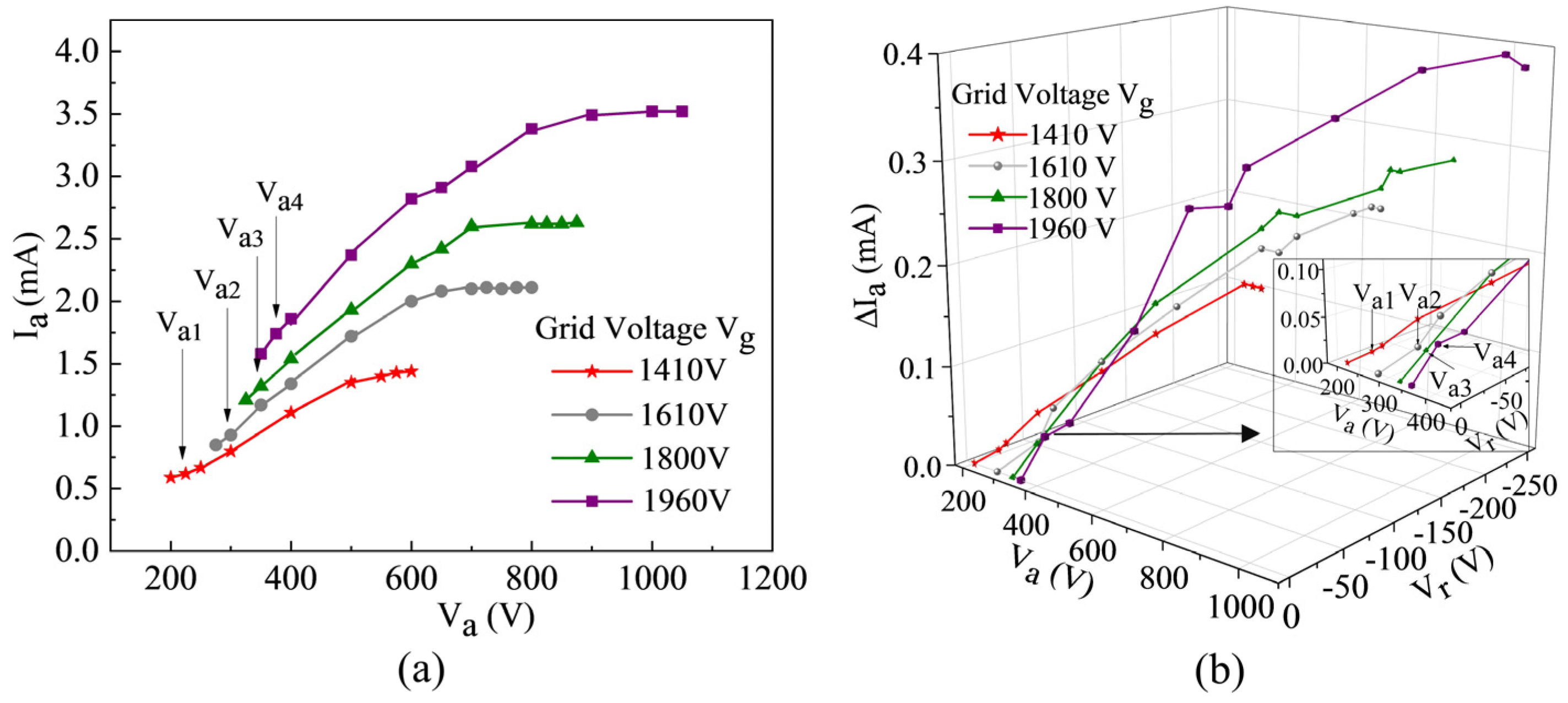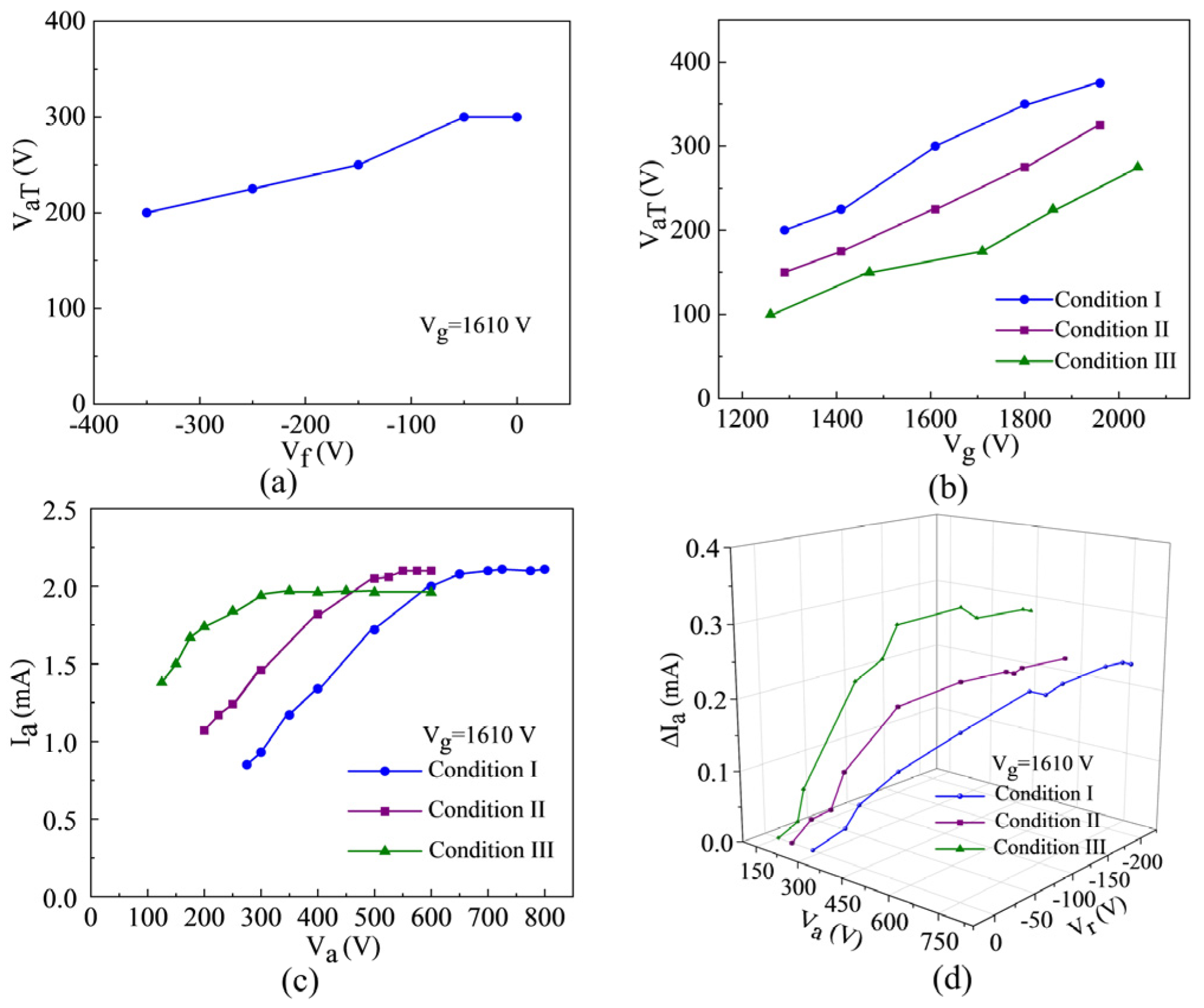A Carbon-Nanotube Cold-Cathode Reflex Klystron Oscillator: Fabrication @ X-Band and Returning Electron Beam Realization
Abstract
:1. Introduction
2. Design and Fabrication
3. Results and Discussion
4. Conclusions
Author Contributions
Funding
Data Availability Statement
Conflicts of Interest
References
- Jeon, S.G.; Jin, Y.S.; Kim, J.I.; Kim, G.J.; Shon, C.H. Three-dimensional Particle in-cell Simulations of 300 GHz Reflex Klystrons. J. Appl. Phys. 2007, 101, 054519. [Google Scholar]
- Jang, K.H.; Jeon, S.G.; Kim, J.I.; Won, J.H.; So, J.K.; Bak, S.H.; Srivastava, A.; Jung, S.S.; Park, G.S. High Order Mode Oscillation in a Terahertz Photonic-band-gap Multibeam reflex klystron. Appl. Phys. Lett. 2008, 93, 211104. [Google Scholar] [CrossRef]
- Varian, R.H.; Varian, S.F. A High Frequency Amplifier and Oscillator. J. Appl. Phys. 1939, 10, 140. [Google Scholar] [CrossRef]
- Xu, N.; Huq, S.E. Novel Cold Cathode Materials and Applications. Mat. Sci. Eng. R 2005, 48, 47–189. [Google Scholar] [CrossRef]
- Manohara, H.M.; Bronikowski, M.J.; Hoenk, M.; Hunt, B.D.; Siegel, P.H. High-current-density Field Emitters Based on Arrays of Carbon Nanotube Bundles. J. Vac. Sci. Technol. B 2005, 23, 157–161. [Google Scholar]
- Iijima, S. Helical microtubules of graphite carbon. Nature 1991, 354, 56–58. [Google Scholar] [CrossRef]
- Monthioux, M.; Kuznetsov, V. Who should be given the credit for the discovery of carbon nanotubes? Carbon 2006, 44, 1621–1623. [Google Scholar] [CrossRef]
- Teo, K.B.K.; Minoux, E.; Hudanski, L.; Peauger, F.; Schnell, J.-P.; Gangloff, L.; Legagneux, P.; Dieumegard, D.; Amaratunga, G.A.J.; Milne, W.I. Microwave Devices-carbon Nanotubes as Cold Cathodes. Nature 2005, 437, 968–969. [Google Scholar] [CrossRef] [PubMed]
- Manohara, H.; Dang, W.L.; Siegel, P.H.; Hoenk, M.; Husain, A.; Scherer, A. Field Emission Testing of Carbon Nanotubes for THz Frequency Vacuum Microtube Sources. In SPIE Reliability, Testing, and Characterization of MEMS/MOEMS III; SPIE: Bellingham, WA, USA, 2003; Volume 5343, pp. 227–234. [Google Scholar]
- Xing, Y.; Zhang, Y.; Xu, N.; Huang, H.; Ke, Y.; Li, B.; Chen, J.; She, J.; Deng, S. Design and Realization of Microwave Frequency Multiplier Based on Field Emission from Carbon Nanotubes Cold-Cathode. IEEE Trans. Electron. Dev. 2018, 65, 1146–1150. [Google Scholar] [CrossRef]
- Thorpe, J.R.; Fletcher, J.R.; Chamberlain, J.M.; Miles, R.E.; Garcia-Garcia, J.; Mann, C.J.; Huq, E.; Oldfield, M.; Spencer, J. Development of a Submillimeter Wave Reflex Klystrons. In Proceedings of the 10th IEEE International Conference on Terahertz Electronics, Cambridge, UK, 9–10 September 2002. [Google Scholar]
- Xing, Y.; Zhang, Y.; Xu, N.; Huang, H.; Ke, Y.; Li, B.; Deng, S. A Cold-Cathode Microwave and Terahertz Radiation Source: Experimental Realization @10′s GHz and Computational Design @THz. IEEE Trans. Electron. Dev. 2019, 40, 1534–1537. [Google Scholar] [CrossRef]
- Xu, X.; Yuan, X.; Chen, Q.; Cole, M.T.; Zhang, Y.; Xie, J.; Yin, Y.; Li, H.; Yan, Y. A Low-Voltage, Premodulation Terahertz Oscillator Based on a Carbon Nanotube Cold Cathode. IEEE Trans. Electron. Dev. 2020, 67, 1266–1269. [Google Scholar] [CrossRef]
- Yuan, X.; Wang, B.; Cole, M.T.; Zhang, Y.; Deng, S.; Milne, W.I.; Yan, Y. Theoretical Research on a Multibeam Modulated Electron Gun Based on Carbon Nanotube Cold Cathodes. IEEE Trans. Electron. Dev. 2019, 63, 2919–2924. [Google Scholar] [CrossRef] [Green Version]
- Jang, K.-H.; Park, S.H.; Lee, K.; Park, G.-S.; Jeong, Y.U. High-order Photonic Bandgap Reflex Klystron Using Carbon Nanotube multi-beam Cathode. Electron. Lett. 2012, 48, 707–708. [Google Scholar] [CrossRef]
- Manohara, H.M.; Siegel, P.H.; Marrese, C.; Chang, B.; Xu, J. Design and Fabrication of a Thz Nanoklystron. In Proceedings of the Far-IR, Sub-mm & MM Detector Technology Workshop, Monterey, CA, USA, 1–3 April 2002. [Google Scholar]
- Garcia-Garcia, J.; Martín, F.; Miles, R.E. Optimization of Micromachined Reflex Klystrons for Operation at Terahertz Frequencies. IEEE Trans. Microw. Theory Technol. 2004, 52, 2366–2370. [Google Scholar] [CrossRef]
- Balucani, M.; Scafè, S.; D’Inzeo, G.; Paffi, A.; Ferrara, V.; Nenzi, P. Nano-Klystron: New Design and Technology for THz Source. In Proceedings of the 6th UK, Europe, China Millimeter Waves and THz Technology Workshop (UCMMT), Rome, Italy, 9–11 September 2013. [Google Scholar]
- Jang, K.-H.; Lee, K.; Park, S.H.; Miginsky, S.; Jeong, Y.U. Frequency Multiplying Oscillator with an Electron Beam Accelerated in a Drift Space. Appl. Phys. Lett. 2012, 101, 013507. [Google Scholar] [CrossRef]
- Li, J.; Zhang, Y.; Ke, Y.; Li, B.; Deng, S. A Cold Cathode Electron Gun Using Convex Carbon Nanotube Emitter. IEEE Trans. Electron. Dev. 2022, 69, 1457–1460. [Google Scholar] [CrossRef]
- Oberlin, A.; Endo, M.; Koyama, T. Filamentous growth of carbon through benzene decomposition. J. Cryst. Growth. 1976, 32, 335–349. [Google Scholar] [CrossRef]
- Radushkevich, L.V.; Lukyanovich, V.M. On the structure of carbon produced at thermal decomposition of carbon monoxide on an iron contact. J. Phys. Chem. 1952, 26, 88–95. [Google Scholar]
- Fletcher, J.R.; Thorpe, J.R.; Huq, E.; Mann, C.; Steenson, D.P.; Chamberlain, M. Design Considerations for Submillimeter-Wave Reflex Klystrons. IEEE Trans. Microw. Theory Technol. 2004, 52, 2344–2351. [Google Scholar] [CrossRef]





Publisher’s Note: MDPI stays neutral with regard to jurisdictional claims in published maps and institutional affiliations. |
© 2022 by the authors. Licensee MDPI, Basel, Switzerland. This article is an open access article distributed under the terms and conditions of the Creative Commons Attribution (CC BY) license (https://creativecommons.org/licenses/by/4.0/).
Share and Cite
Li, J.; Zhang, Y.; Ke, Y.; Hong, T.; Deng, S. A Carbon-Nanotube Cold-Cathode Reflex Klystron Oscillator: Fabrication @ X-Band and Returning Electron Beam Realization. Electronics 2022, 11, 1231. https://doi.org/10.3390/electronics11081231
Li J, Zhang Y, Ke Y, Hong T, Deng S. A Carbon-Nanotube Cold-Cathode Reflex Klystron Oscillator: Fabrication @ X-Band and Returning Electron Beam Realization. Electronics. 2022; 11(8):1231. https://doi.org/10.3390/electronics11081231
Chicago/Turabian StyleLi, Jiupeng, Yu Zhang, Yanlin Ke, Tianzeng Hong, and Shaozhi Deng. 2022. "A Carbon-Nanotube Cold-Cathode Reflex Klystron Oscillator: Fabrication @ X-Band and Returning Electron Beam Realization" Electronics 11, no. 8: 1231. https://doi.org/10.3390/electronics11081231
APA StyleLi, J., Zhang, Y., Ke, Y., Hong, T., & Deng, S. (2022). A Carbon-Nanotube Cold-Cathode Reflex Klystron Oscillator: Fabrication @ X-Band and Returning Electron Beam Realization. Electronics, 11(8), 1231. https://doi.org/10.3390/electronics11081231





